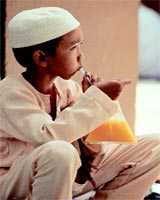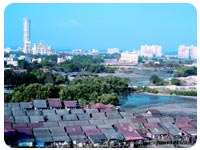|
The
People
|
57%
Malay
& Indigenous Groups
|
33%
Chinese |
10%
Indians
|
Malaysia
was originally inhabited by native aboriginal peoples known collectively
as the Orang Asli, which means 'original people'. They migrated
from South-West China 10,000 years ago. Although Malays make up
the biggest proportion of the population, Malaysia today is a multiracial
country. In Sarawak alone, there are 25 different indigenous groups
known as the Dayaks, each with its own history and customs.
Bahasa
Malaysia is the official language, but many Malaysians speak more
than one language depending on their cultural background. Because
Malaysia was a British colony English is widely spoken, particularly
in the business world.
Click
here
to find out about the main religions in Malaysia
The
Economy
In
the past, Malaysia relied on primary industries for its main source
of income.
In
addition to rubber and tin, half the world's supply of palm oil,
a raw material used in food products and soap, comes from Malaysia's
plantations, and the forests of Sabah and Sarawak are still one
of the world's major sources of tropical timber. However, as Malaysia
industrialises, primary products are being replaced by manufactured
goods as the country's main exports. The manufacture of electronic
goods has become Malaysia's biggest growth area. By improving their
own skills and expertise, Malaysian companies are able to develop
their own technologies and products rather than put together components
that are made elsewhere.
Click
here
to find out how the export of electronic goods has boomed in
recent years:
Unequal
Development
The
benefits of Malaysia's industrialisation are not shared out equally
across the country. Much of the growth in electronics companies
is concentrated in major urban centres like Kuala Lumpur and Georgetown
on Penang island. These pockets of prosperity attract migrants in
search of work from other parts of the country, and from abroad.
In contrast, the state of Sarawak has very little manufacturing
industry, and relies on the sale of timber for half its income.
�
|
To
find out how Malaysia's economic development varies from state
to state, click
here to see a map of the average annual GDP per person
for each of the thirteen states of Malaysia.
|
|
 |
|
�Chris
Stowers/Panos Pictures
|
|
53%
of Malaysians are Muslim
|
|
Click
on the image for a larger picture

|
|
�Tavacan/Panos
Pictures.
|
|
Poor
housing areas are growing on the edge of Malaysia's urban
centres as migrants move to take advantage of the new job
opportunities
|
|

